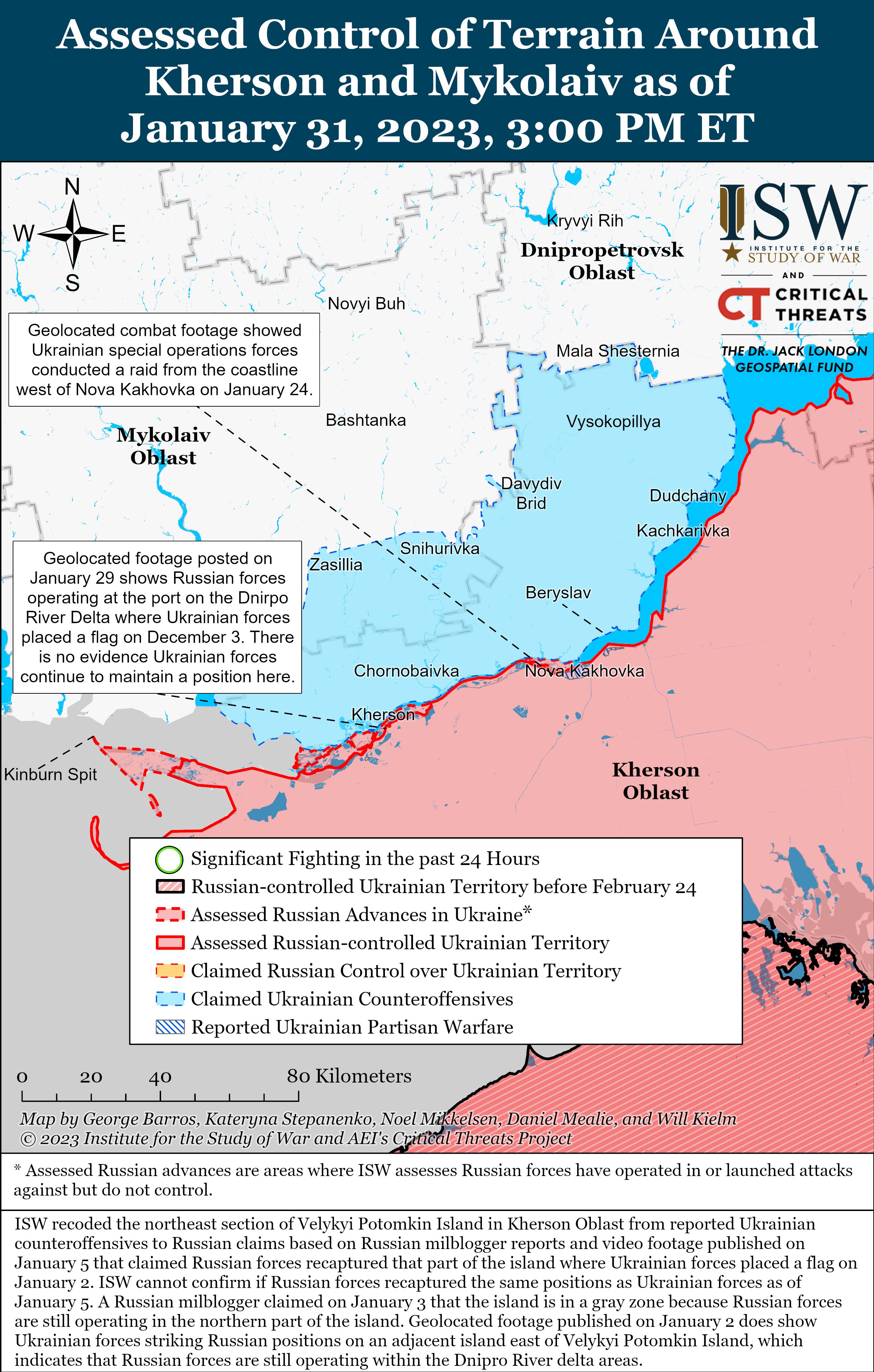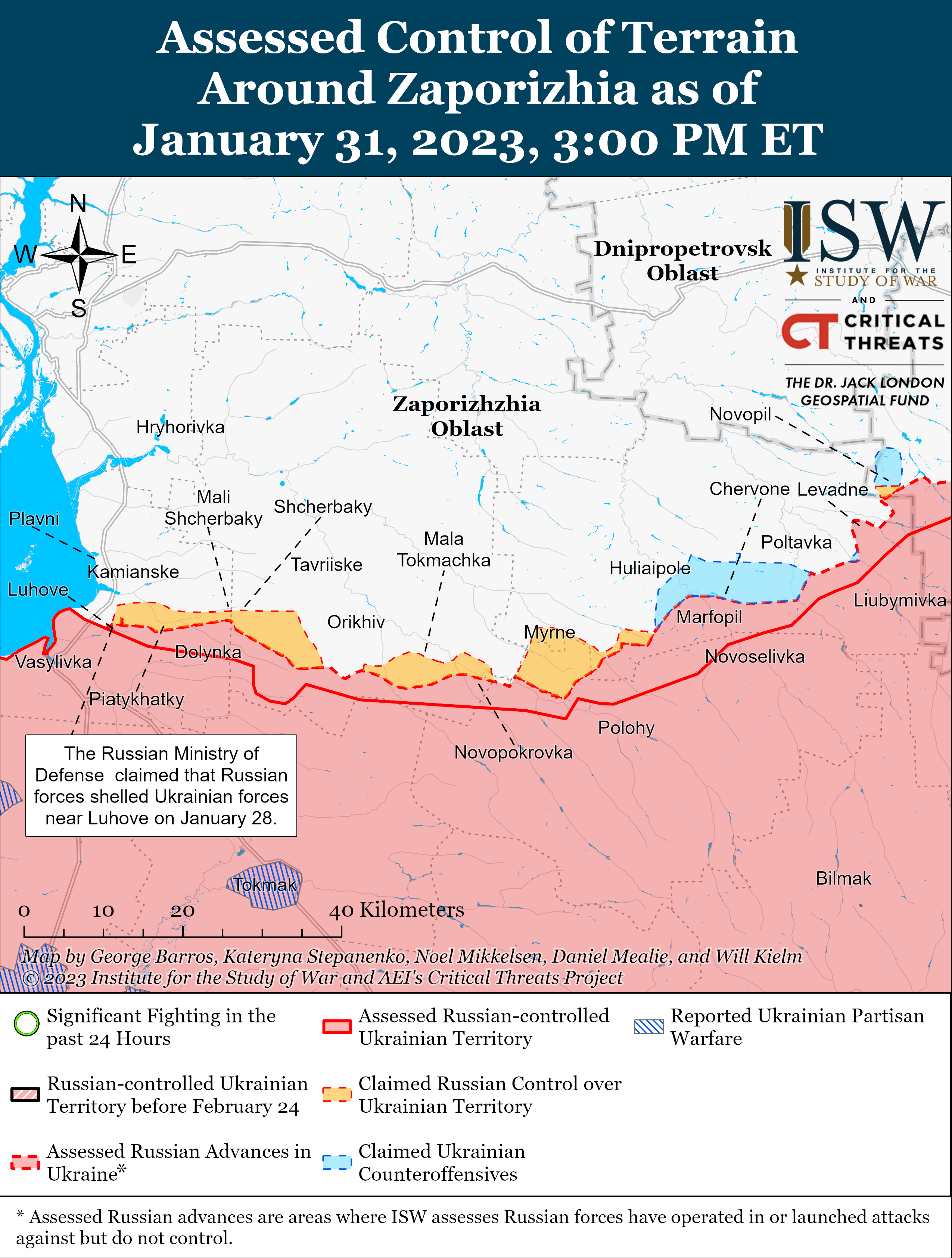Ukrainian Military Defeats Major Russian Forces Near Ugledar
- 1.02.2023, 8:24
- 15,186
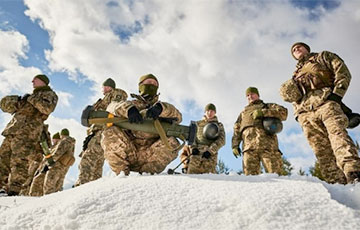
The most experienced occupant formations were defeated.
In the past 24 hours, January 31, the AFU fought the Russians 42 times near Bakhmut. Near Ugledar, the Ukrainian military defeated the most experienced occupant formations.
This is reported by the Institute for the Study of War (ISW).
Counteroffensive in eastern Kharkiv and western Luhansk Oblasts
Russian forces continued limited ground attacks to regain lost positions along the Svatove-Kreminna line on January 31. The Ukrainian General Staff reported that Ukrainian forces repelled Russian offensives near Novoselovske (16 km northwest of Svatove) and Belohorivka (12 km south of Kreminna) in Luhansk Oblast and Yampolivka (16 km west of Kreminna) in Donetsk Oblast. On 31 January, Colonel Serhiy Cherevaty, a representative of Ukraine's Eastern Group of Forces, stated that the Ukrainian offensive on the Svatove-Kreminna line had slowed down. Geolocation video footage of the fighting, released on January 30, shows Russian artillery shelling Ukrainian positions about 8 km west of Kreminna, indicating that Ukrainian forces had advanced within 8 km of the settlement.
Ukrainian forces continued to deliver strikes against Russian concentrations in the occupied Luhansk Oblast. Geolocated photos published on January 31 confirm claims by the so-called LPR that Ukrainian forces struck Kadiivka (48 km west of Luhansk on the T0504 Lysychansk-Luhansk highway) with HIMARS. Ukrainian military defeated major Russian forces near Ugledar: battle maps
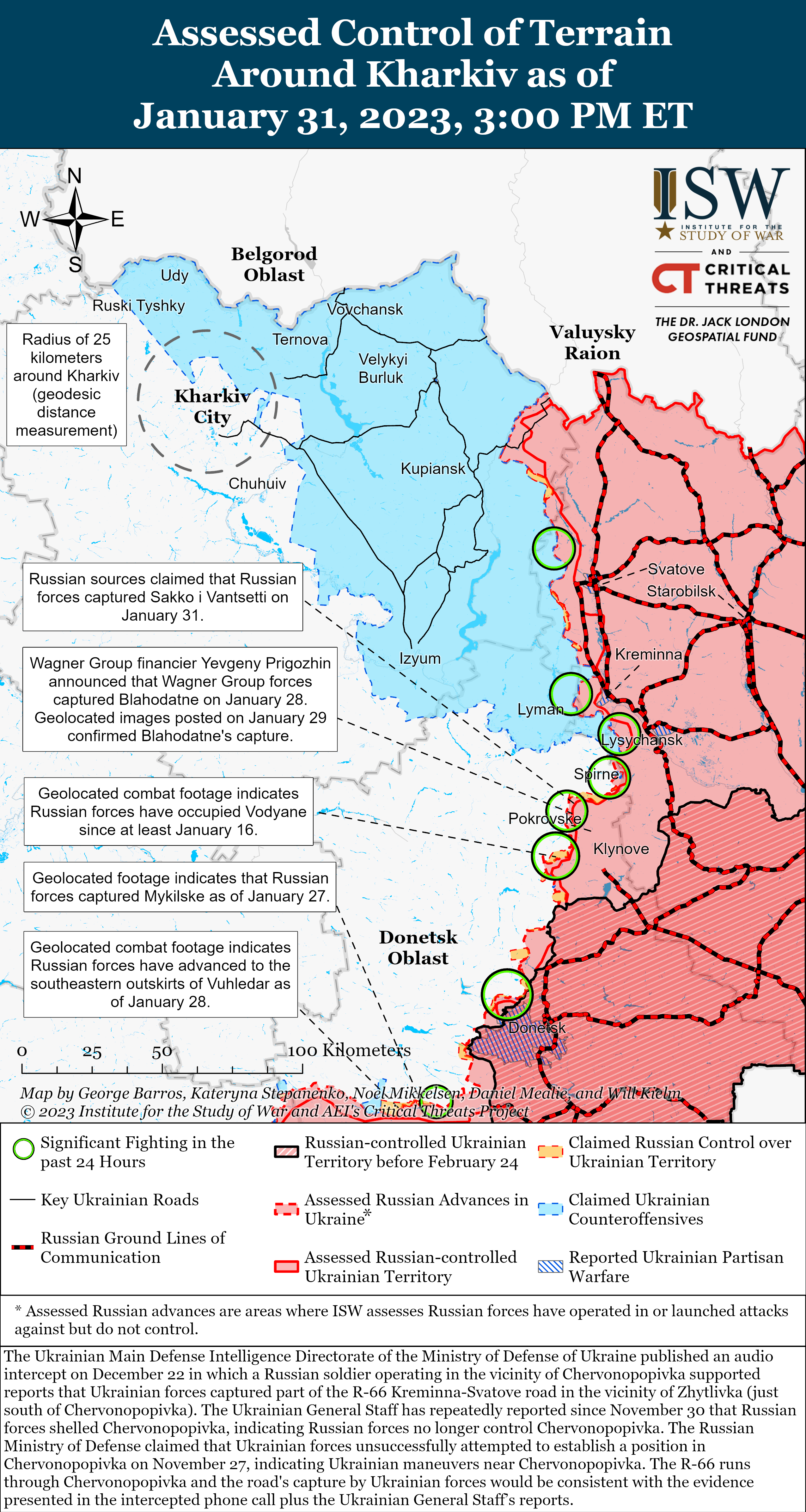
Situation in Donbas
On January 31, Russian troops continued their offensive near Bakhmut. A representative of Ukraine's Eastern Group of Forces, Serhiy Cherevatiy, reported that 42 military actions occurred between Ukrainian and Russian forces near Bakhmut over the past 24 hours. The Ukrainian General Staff reported that Ukrainian forces repelled Russian assaults near Bakhmut itself; 29 km northeast of Bakhmut near Sporne, Krasna Gora and Paraskoviivka; and within 7 km southwest of Bakhmut near Ivanovske and Kleshchiivka. A source affiliated with the 105th Rifle Regiment of the so-called DPR claimed that Russian forces captured Sacko and Vancetti (17 km north of Bakhmut), although ISW found no visual evidence to support this claim.
The Russian Defense Ministry said that "volunteer paratrooper assault units," supported by regular Russian units, had captured Blaрodatne (11 km north of Bakhmut), after Wagner Group owner Yevgeny Prigozhin claimed on January 28 that his fighters had seized the settlement. ISW previously reported that geolocation footage released on January 29 indicated that Russian troops had probably captured the settlement. The Russian Defense Ministry continues to refer to the Wagner group as "volunteer paratroopers" to minimize their responsibility for tactical offensives near Bakhmut while acknowledging their role. A source in the 105th Rifle Regiment of the so-called DPR claimed that Russian troops began a massive assault on Bakhmut on January 30 and advanced to the eastern outskirts of the city. The source also claimed that Russian forces had advanced to positions within 1 km of the T0504 Konstantinovka-Bakhmut highway near Ivanovske (6 km west of Bakhmut), although ISW also observed no visual evidence to support this claim.
On January 31, Russian forces continued their offensive in the area of Donetsk - Avdiivka. The Ukrainian General Staff reported that Ukrainian forces repelled Russian assaults near Avdiivka, Vodyane (7 km southwest of Avdiivka) and Pervomaiske (11 km southwest of Avdiivka). A source affiliated with BARS-13 (Russian national combat reserve) claimed that elements of BARS-14 destroyed a Ukrainian sabotage and reconnaissance group near Makiivka (27 km southwest of Avdiivka).
On January 31, Russian troops continued localized offensives in the west of Donetsk Oblast. The Ukrainian General Staff reports that Ukrainian troops repelled Russian assaults near Ugledar (30 km southwest of Donetsk). On January 29, a Russian "war correspondent" published footage reporting that Russian tank units of the 36th separate Guards Motorized Rifle Brigade of the 29th All-Arms Army of the Eastern Military District were fighting on Ukrainian tank units near Ugledar. A Ukrainian military officer reported that Russian forces failed to gain control of positions near Ugledar, and that heavy losses and bad weather were holding back Russian combat capability in the area.
The Ukrainian military said that during the first days of the Russian assault recovery near Ugledar, the Ukrainian forces eliminated the most experienced Russian formations. While 155th MPBr of the Pacific Fleet suffered heavy losses. The Ukrainian military said that Russian forces had amassed a large number of forces in the area and were likely to continue a localized offensive to capture Ugledar. On January 30, Russian sources expanded footage allegedly showing elements of the 155th Marine Brigade entering Ugledar. One Russian source claims that as of January 30, fighting is continuing in the settlement. On January 31, a Russian military correspondent stated that Ukrainian forces moved a large number of personnel to the area of Ugledar.
Russian forces are unlikely to benefit elsewhere in eastern Ukraine from a localized offensive around Ugledar. The U.K. Department of Defense reported that Russian forces are likely to have transformed probing attacks near Pavlivka (36 km southwest of Donetsk) and Ugledar into a more coordinated offensive assault to develop a new direction of advance in Donetsk Oblast. The development of the new direction of Russian advance is unlikely to enhance other Russian offensive operations in eastern Ukraine, as the lack of overall operational coordination between these separate offensives and the distance between them. ISW previously assessed that the localized Russian offensive near Ugledar is part of a broader attempt to disperse Ukrainian forces along the front lines in Ukraine and set the stage for a decisive Russian offensive in western Luhansk Oblast. Russian forces will likely have to intensify a large-scale offensive from the Donetsk area to create operational cohesion between the offensive around Ugledar and the operations around Bakhmut. ISW observes no evidence of Russian preparations for such an offensive.
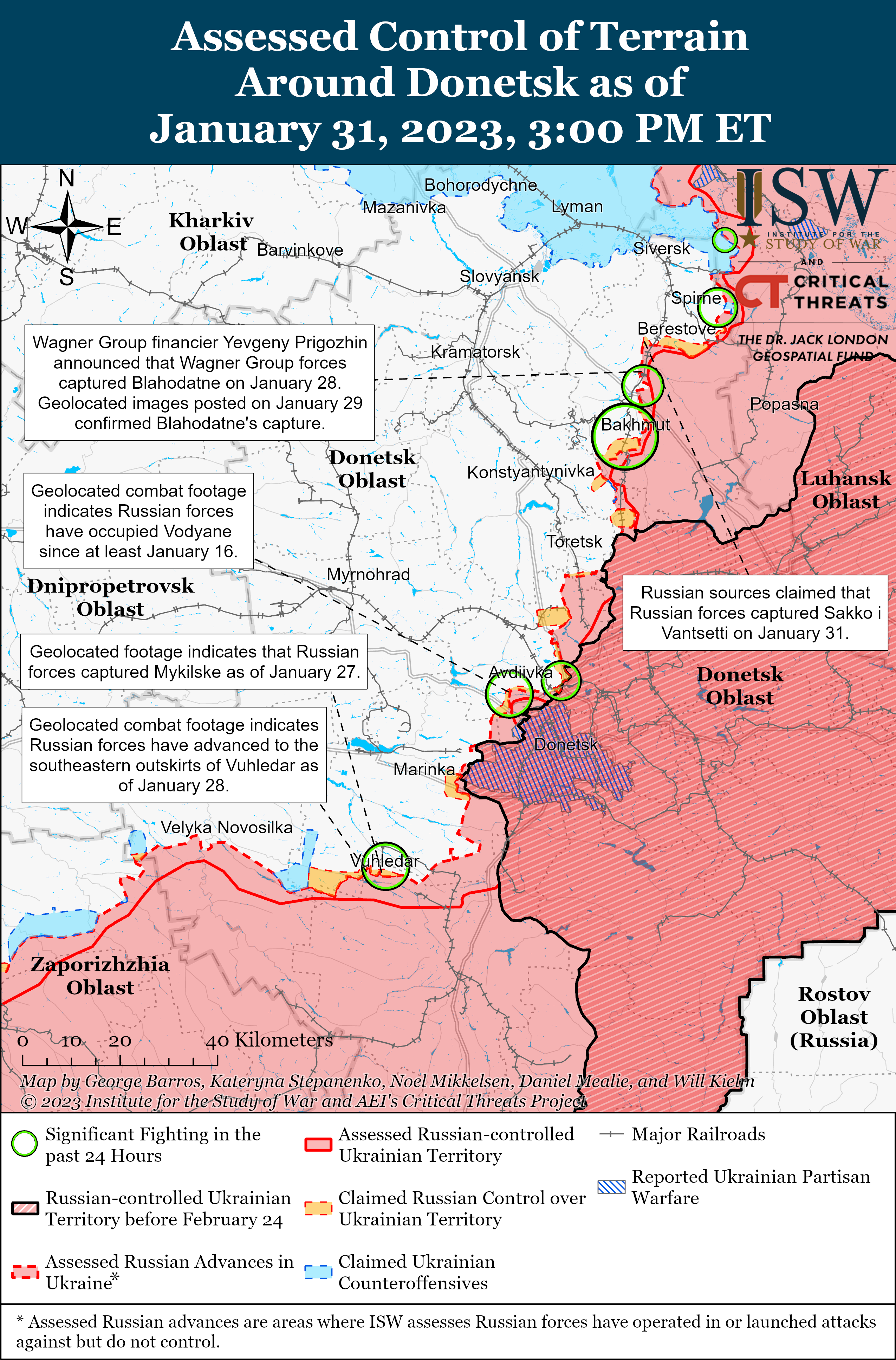
Southern Axis
It is likely that Russian troops prefer sabotage and reconnaissance activities to territories in the south of Ukraine. Colonel Yevgeniy Yerin, head of the Ukrainian press center of the Tavria Defense Forces, said that Russian sabotage and reconnaissance groups had stepped up their activities in Dnipro in Kherson Oblast and along the front line in Zaporizhzhia Oblast. They were not trying to seize territory. On January 31, the Ukrainian General Staff reported that over the past 24 hours, Ukrainian troops destroyed at least five Russian sabotage and reconnaissance boats in Dnipro. Russian and Ukrainian sources did not report that Russian troops carried out ground attacks in Zaporizhzhia Oblast for the fifth consecutive day on January 31. These reports (or lack thereof) confirm ISW's preliminary assessment that statements by occupation official Vladimir Rogov about the ongoing Russian offensive in Zaporizhzhia Oblast were likely exaggerated as part of a Russian information operation.
Ukrainian troops raided the eastern (left) bank of the Dnipro River on January 31. Geolocation images from January 31 show two boats on the Dnipro River near the delta islands southwest of Kherson. Russian sources reported that Ukrainian forces briefly landed nearby and took up positions in a residential area on the riverbank before Russian artillery fire forced Ukrainian forces to abandon the eastern bank. A Russian military correspondent claimed that Ukrainian forces were scouting Russian positions and possibly trying to fix Russian forces in Kherson Oblast, but did not intend to establish a bridgehead on the eastern bank of the Dnipro River. Intermittent Ukrainian raids on the eastern bank of the Kherson Oblast continue to demonstrate that Russian forces probably do not have full control over the eastern bank of the Dnipro River, as previously reported by ISW.
Russian occupation authorities continue to work to restore the Russian logistic line between Krasnodar Krai and Crimea. Russian Deputy Prime Minister Marat Khusnullin said that on January 31, authorities resumed the fourth and last span of the road bridge over the Kerch Strait. On January 26, the occupying authorities installed the third span of the road bridge. Khusnullin reiterated that Russia plans to reopen the Kerch Bridge for automobile traffic in March 2023.
On January 31, Russian troops continued to launch routine artillery strikes in areas of Zaporizhzhia, Kherson, Mykolaiv, and Dnipropetrovsk Oblasts.
